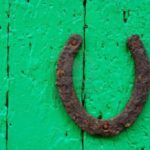E’ da parecchi anni che non ho da fare i compiti a casa per le vacanze di Natale, ma ………. la nostra ‘teacher’ di inglese questa volta mi ha incastrato !
Quindi: fuori il dente, fuori il dolore.
The origin of ” touch iron.
“It’s short for” touch horseshoe “and the significance of making incantations , accompanied mostly by concrete gesture of shaking or touching a piece of iron to protect themselves from the evil eye and misadventures . During the Middle Ages it was nailed an iron horse at the door to keep away witches . The origin of this superstition is English. legends tell that one day the devil in disguise, came to St. Dunstan who was a blacksmith , begging him to shoe the porcine foot . The saint knew immediately that the customer was the devil and treated him properly. Still he tied him to the wall with a chain, he forged iron with a nice right fit and nailed it to the sound of hammering in the paw of the unsavory client. Unnecessarily this screamed but the saint continued to beat with violent hammering the foot of the beast that had pretending to be won and beg for mercy The blacksmith saint then as a counterpart of the liberation tore the evil promise never to enter a place where there was a horseshoe. Still the horseshoe is considered a lucky charm , especially if you find a path with the nails still frames . Even a nail in his pocket he brought bad luck functions such as iron. a suggestion to those that hold the iron horse at the door, make sure that it is nailed with two arms upward and secured with an odd number of nails, which only need to hold it and not go through the holes that attach it to the hoof of the horse. nails should be rusty . the Nordic tradition instead of ” touch iron” it says ” touch wood.” it should be borne in mind that the name of the wood in all the Celtic languages is the same name of science, knowledge, and trees, especially birch, apple, rate , are present in all the symbols of life and death.
Per chi non ha molta confidenza con l’inglese qui di seguito c’è (più o meno) la traduzione.
Per l’origine di “toccare ferro” .
“È l’abbreviazione di “toccare ferro di cavallo” e ha il significato di fare scongiuri, accompagnato per lo più dal gesto concreto di stringere o toccare un pezzo di ferro per proteggersi dalla iettatura e dalle disavventure. Nel Medio Evo si inchiodava un ferro di cavallo alla porta per tenere lontano le streghe. L’origine di questa superstizione è inglese. Raccontano le leggende che un giorno il diavolo, sotto mentite spoglie, si presentò a san Dunstano che era un maniscalco, pregandolo di ferrargli il piede porcino. Il santo capì subito che il cliente era il demonio e lo trattò a dovere. Lo legò fermo al muro con una catena, gli forgiò un bel ferro a giusta misura e l’inchiodò a suon di martellate nella zampa del poco raccomandabile cliente. Inutilmente questo si mise a urlare ma il santo continuava a battere con violente martellate il piede della bestia che dovette darsi per vinta e chiedere pietà. Il santo maniscalco allora come contropartita della liberazione strappò al maligno la promessa di non entrare mai più in un luogo dove ci fosse un ferro di cavallo. Ancora oggi il ferro di cavallo è ritenuto un portafortuna, specialmente se trovato in un sentiero con i chiodi ancora infissi. Anche un chiodo portato in tasca ha funzioni scaramantiche come il ferro. Un suggerimento a quelli che fissano il ferro di cavallo alla porta: fate attenzione che sia inchiodato con i due bracci verso l’alto e fissato con un numero dispari di chiodi, i quali devono solo reggerlo e non passare per i buchi che lo fissano allo zoccolo del cavallo. I chiodi devono essere arrugginiti. Nella tradizione nordica invece di “toccare ferro” si dice “toccare legno”. Va ricordato in proposito che il nome del legno in tutte le lingue celtiche è omonimo di scienza, di sapere, e gli alberi, specialmente la betulla, il melo, il tasso, sono presenti in tutta la simbologia della vita e della morte.
Paolo
p.s.: di compiti per le vacanze ne avrei anche un altro ma (forse) lo farò più avanti, prima del ritorno in aula.


WONDERFUL STUDENT! THANKS A LOT FOR YOUR RESEARCH.